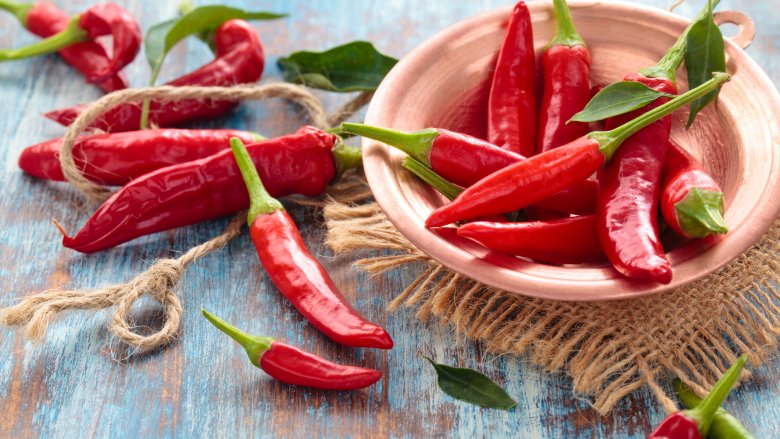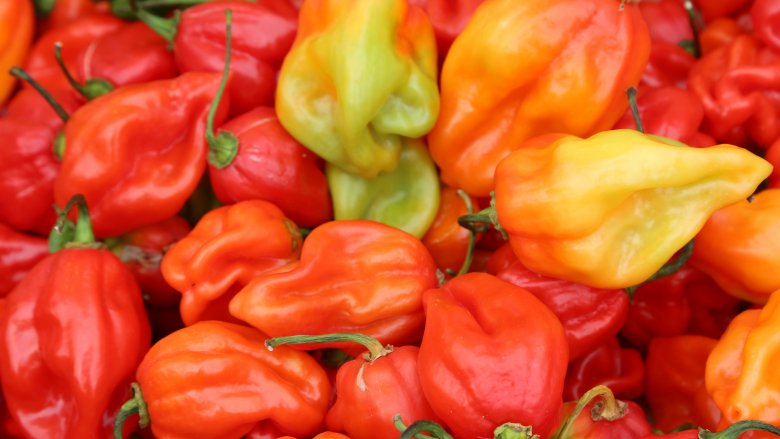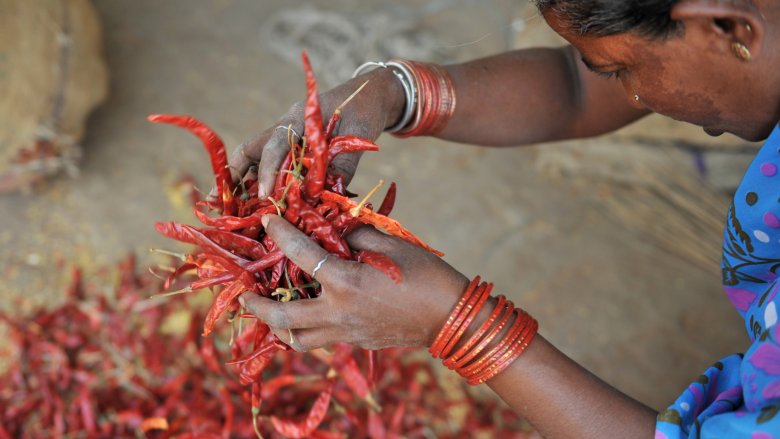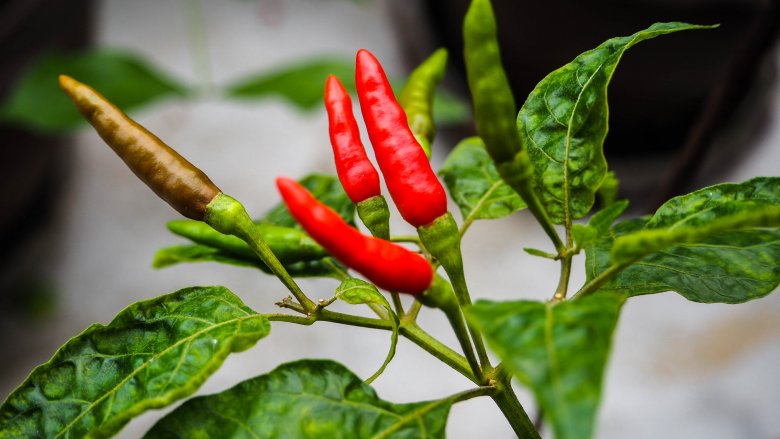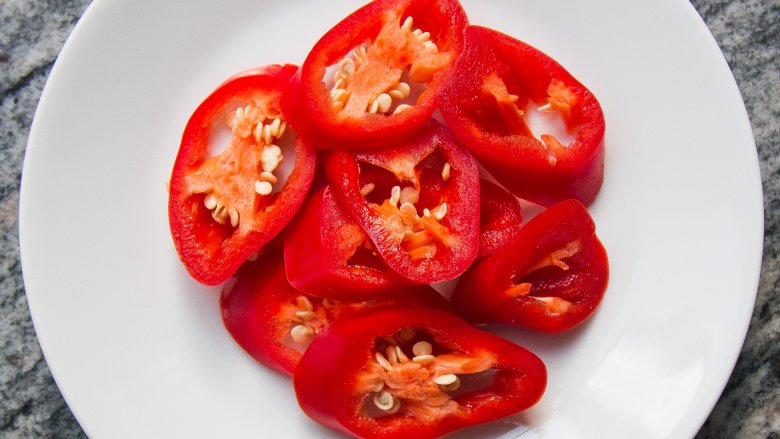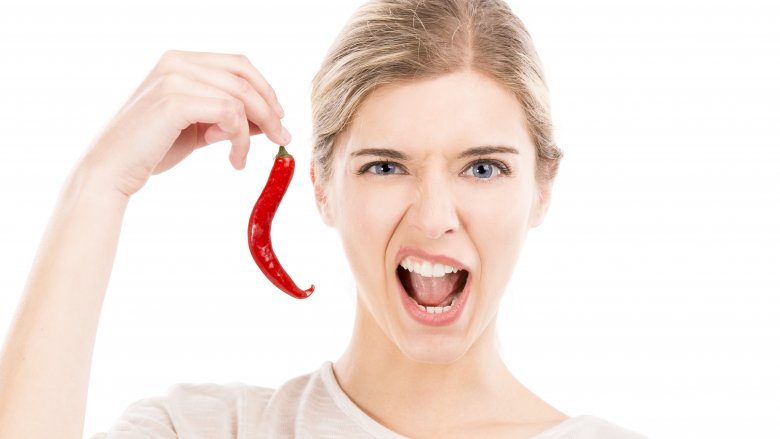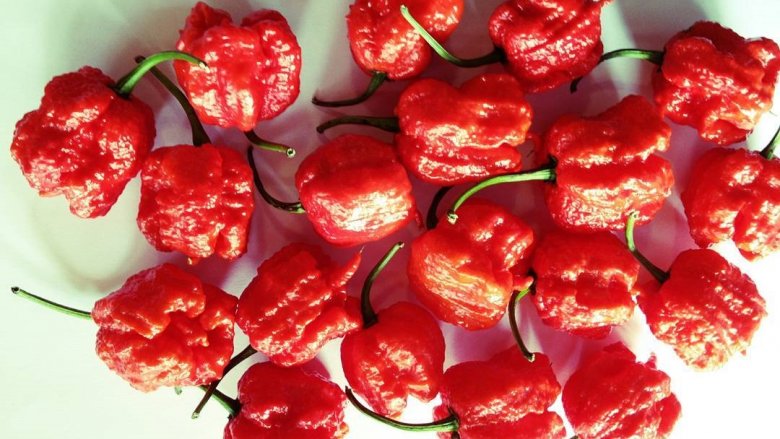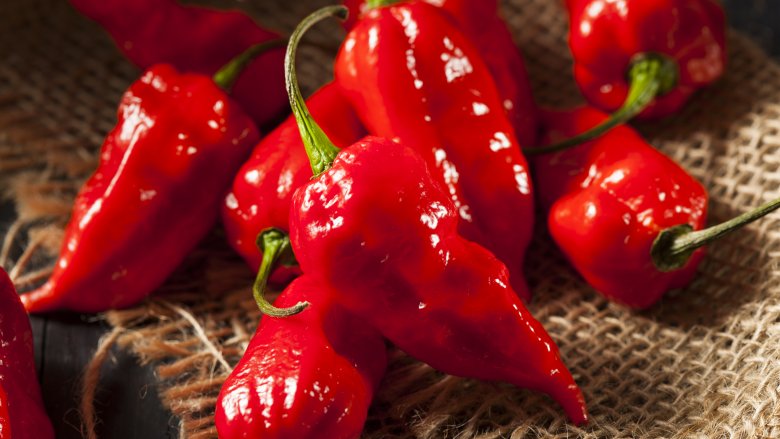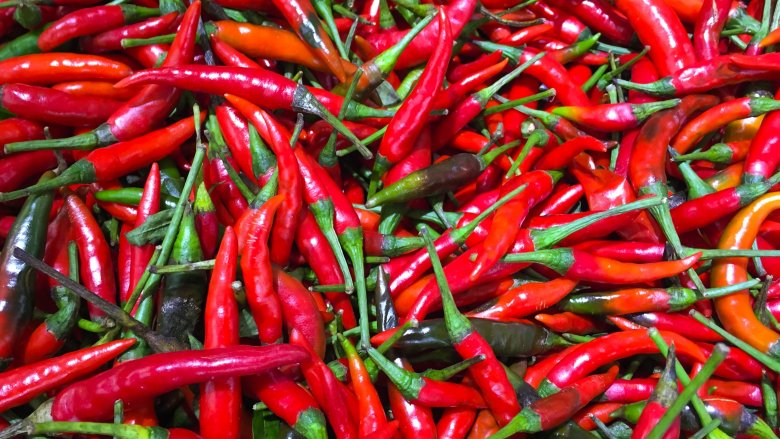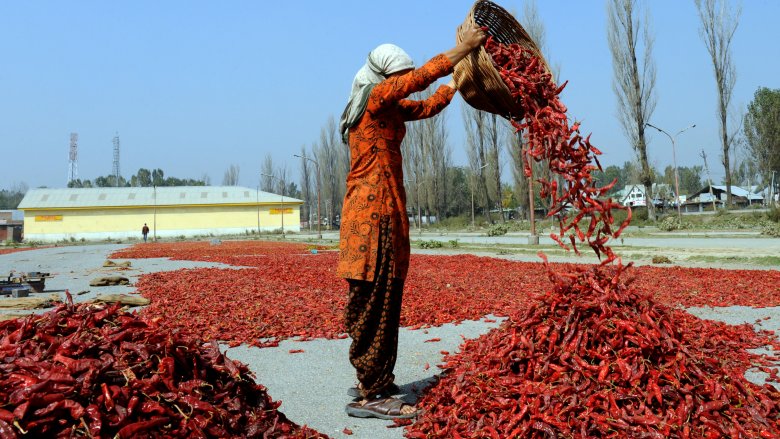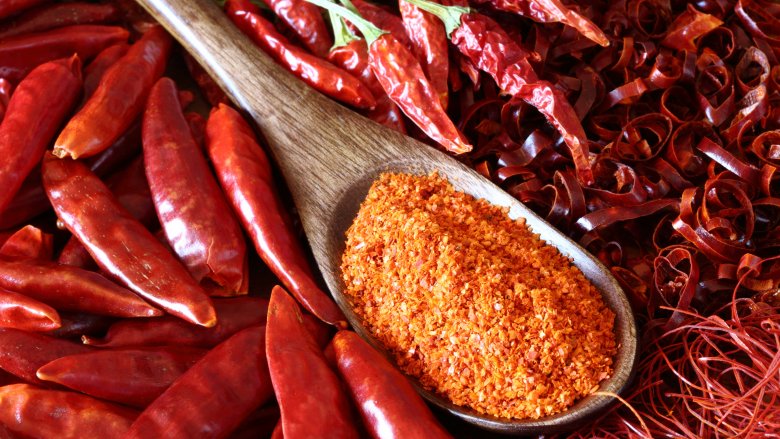The Untold Truth Of The World's Hottest Peppers
Do you like it hot? Like really, really hot? Every family has one, that person who doesn't think something is hot enough until their lips start changing color and they break out in a sweat. Chili peppers aren't just about heat, though. If used correctly, they're about adding a whole different flavor to some of your favorite foods. There's a difference, though, between peppers that are hot and peppers that are dangerous. While there are the peppers that will make your curry something special, there are also peppers that can be weaponized — that's taking hotness to a whole new level. Those dangerously fiery peppers are the peppers we're talking about here. Here's the untold truth of the world's hottest peppers.
Interpreting the Scoville scale
It's impossible to talk about hot peppers without talking about the Scoville scale — the way the hotness of peppers is rated. It was created in 1912 by Wilbur Scoville (via Chilli World), who was on the hunt for a reliable way of measuring heat. Scoville ended up taking a portion of pepper extract and diluting it in sugar water. The amount of dilution needed before the pepper is undetectable is the Scoville rating.
So, let's take a jalapeno. That has a Scoville rating of between 2500 and 8000, meaning it has to be diluted that many times before the heat of the pepper is completely neutralized by the solution. For more perspective, a meal that's considered restaurant-quality spicy generally rates between 500 and 1000, while pure capsaicin is at the very high end of the scale with a rating of 15 to 16 million. Today, there's a more scientific way of determining Scoville ratings, and according to Pepper Seeds, it's done by using chromatography to measure the amount of pure capsaicin in a pepper.
Why we interpret hot peppers as hot
The other thing we need to talk about is what's going on at our side of the equation, and BBC took a look at just why we taste things as being hot and spicy. Capsaicin activates receptors in your tongue, the same ones kick-started by pain. Capsaicin is something of an anomaly, as it's one of the few activators that isn't actually doing any damage, but still sets off receptors.
Studies have found your tongue catches on to this little trick, and gradually, receptors recognize that burning sensation doesn't actually pose a threat. They'll stop reacting, and that's called capsaicin desensitization. It also interacts weirdly with ethanol, which changes the tolerance threshold for capsaicin sensitivity. Try it — have a jalapeno with a warm beer. It will be spicier than if you were drinking it with an ice cold beer. And finally, capsaicin reaction to these non-taste bud receptors is the reason you absolutely don't want to rub your eyes after you've been slicing peppers — all parts of your body will let you know capsaicin is present.
The entire industry was started by one man
Hot peppers have always been around, but it turns out there's one man you can thank for essentially creating the entire industry. That's Dr. Fabian Garcia, a horticulturist from New Mexico State University's very first graduating class, the class of 1894. In addition to planting the first trees of New Mexico's pecan industry, he standardized hot pepper breeds, creating the genetic basis of today's peppers.
It's no coincidence that his alma mater is now the site of the Chile Pepper Institute, and according to director Dr. Paul Bosland (via Desert Exposure), Garcia released his landmark pepper, the New Mexico No. 9, in 1921. Before that pepper, hot peppers were little more than a spice — now they're a multi-million dollar industry.
Dr. Rothwell's hallucinations
It's human nature to try to do everything bigger and better than the next person, and that's not only led to people breeding hotter chilis and making hotter dishes, but also to people trying to actually eat those dishes. In 2013, CNN announced after more than 300 people tried and failed to eat a curry dish filled with 20 Infinity chilis, one man had finally succeeded.
He was Dr. Ian Rothwell, and he managed to finish off the entire plate of curry — a plate so hot anyone who's cooking it needs to wear a gas mask and other protective gear. It took him an hour, and we'll put his achievement in perspective using the Scoville scale. A Tabasco's Original Red Sauce clocks in at between 2500 and 5000 units, while a single Infinity chili is rated between 1,200,000 and 2 million. You know, give or take. Rothwell ate the curry with only a pint of beer to help, took a walk partway through, and started hallucinating. His wife found him wandering the streets while having a conversation with his own hand, but the pep talk apparently worked.
The Dragon's Breath chili was accidental
In May 2017, The Telegraph reported on a Welsh fruit grower who had accidentally created the new world's hottest chili (at the time). They say he had been trying to come up with a neat new entry for the Chelsea Flower Show when he created the Dragon's Breath, which clocked in at a whopping 2.48 million on the Scoville scale. (Even a habanero is between 100,000 and 350,000!)
Mike Smith's chili pepper displaced the Carolina Reaper at the top of the scale, but he says he was looking for something more beautiful than spicy. Spicy he got, though, and according to experts at Nottingham Trent University, it's so hot it could be used as an alternative to anesthetic for people who can't use traditional medicines.
It's hotter than US Army-grade pepper spray (which is about 2 million on our Scoville scale), and in typical British fashion, Smith says he's "chuffed to bits" over his creation.
Ed Currie's pepper breeds
When it comes to the world of growing and breeding hot peppers, Smokin' Ed Currie is at the top of the list. He's the head of the PuckerButt Pepper Company, creator of the Carolina Reaper, and when asked if he'd recommend someone actually try to eat one, he said (via Munchies), "[...] I don't recommend it at all. It is very stupid and I am an idiot for doing it." He likens a quick test of a Carolina Reaper to "licking the sun," and that's perspective.
For Currie, there's a practical reason for creating something so unbearably hot. For companies who rely on chilis to give their product an extra kick of heat, they can buy Carolina Reapers and use a much smaller number of peppers to spice up an industrial-sized batch. "It only takes an ounce of my stuff compared to a pound of someone else's to produce the same amount of heat," Currie says, and that's just smart economics.
Currie told The LA Times it all began when he read a scientific paper suggesting the chemicals in peppers might help protect against the development of heart disease and cancer, and that's a cause we can all get behind.
Pepper X took 10 years of breeding to create
To give you an idea of how competitive the world of chili-breeding is, it was only in May 2017 the Dragon's Breath was declared top dog. In October, Ed Currie announced he'd created something even hotter, and he called it Pepper X. According to Currie (and Thrillist), this new bad boy of the chili world sits at about 3.18 million Scoville units.
You can actually try this one, if you're brave enough, because it's used in a sauce called The Last Dab. (You can find it on the Heatonist site). By all accounts it's accurately named, because the sauce alone is said to have a Scoville rating of around 2.4 million (pending confirmation).
According to IFLScience!, Pepper X is the final product of 10 years of selectively breeding chilis to create something unthinkably hot.
India's ghost chili is used in grenades
The ghost chili isn't the hottest pepper on the planet by a long shot — at least, not anymore. But it's still twice as hot as the nearest competitor — the Mexican red savina — and sits at just over a million Scoville units. In 2010, The Guardian reported the Indian military was looking at weaponizing the ghost chili, and they totally did. According to a 2012 follow-up, all kinds of good things started coming from the idea to use ghost chilis as a secret ingredient in grenades. Between military demand and demand from overseas, the ghost chili is providing not just a livelihood for farmers in Assam, but it's a way to climb out of the poverty that has stricken the area.
These chilis made a man go deaf
In August 2017, a man did a very dumb thing. Ben Sumadiwiria ate some "death noodles", made in Indonesia with 100 Thai chilis. For some perspective, each one is between 100,000 and 225,000 on the Scoville scale (while the more popular poblanos come in at between 1000 and 2000). Sumadiwiria scarfed down the noodles then stuck his head under cold water after going temporarily deaf.
Is this something you need to worry about the next time you challenge yourself with hot peppers? According to Dr. Michael Goldrich, a Robert Wood Johnson University Hospital otolaryngologist (via LiveScience), it's possible his ears were temporarily blocked by all the mucus his body was producing to try to counteract the heat. Loyola Medicine's Department of Otolaryngology chair Dr. Sam Marzo had another theory, and that's hearing loss caused by the over-stimulation of the trigeminal nerve. That's the same thing that causes migraine sufferers so much pain, but Goldrich says hearing loss is not only rare, but that capsaicin has been shown to help protect the same cells and hairs that detect sound waves. So eat away... just maybe not so much, not so fast.
They can be dangerous... but they probably won't kill you
Stories of the hottest peppers have gone viral, along with warnings that eating these peppers might be lethal. According to Gizmodo, doomsayers claim things like anaphylactic shock and a burned respiratory system waited for anyone foolish enough to try to eat one of these peppers — but that's not true. In order to consume a lethal dose of capsaicin, you'd need to eat half a pound of Dragon's Breath peppers... and no one's going to do that.
That's not to say there aren't dangers. In 2016, The Telegraph reported on a man who took part in a chili-eating contest and suffered what they called a "spontaneous esophageal rupture," which is exactly what it sounds like. In 2011, the BBC said two competitors trying to take on a "killer curry" contest ended up in the hospital. There's a very important lesson about moderation in there somewhere.
There's a huge community that takes hot peppers very, very seriously
So, aside from the medical, military, and industrial applications of these super-hot peppers, who is trying to make the biggest and the baddest? And, perhaps more importantly, who's eating them?
There's a whole community out there filled with people who consider themselves chili pepper connoisseurs, pepperheads, or chiliheads. When The Atlantic took a look at the community in 2013, they found it wasn't a super-nice place to be. With no one ruling body — aside from the Guinness Book of World Records — they say there's a ton of infighting, negativity, and false claims made throughout the worldwide community of growers. Even Ed Currie — who never considered himself part of the community — was the target of some serious internet hate, to the point where others had to warn him what was going on behind his back. Currie even has a legal team in place to deal with the hate and the attempts to cash in on his peppers, and refuses to send anyone seed pods. "People are pretty much backstabbers," he said, and that's a horrible outlook to be forced to have.
